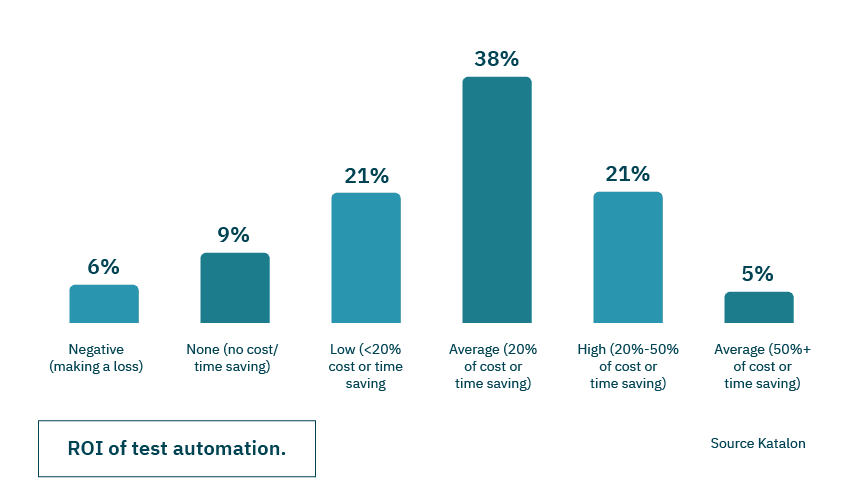Software testing is one of the most expensive and cumbersome components of any IT budget. According to Capgemini’s 2021-2022 World Quality Report, the majority of firms automate only 20% or less of their potential testing capacity.
This indicates that at least 80% of testing is still manual. That’s a lot of time and money being wasted on an outdated methodology. It’s like riding a steam locomotive when you could be on a jet plane. Manual testing is rapidly becoming a thing of the past.
“Time is money, and automation saves both by automating repetitive tests and finding bugs early.”
Why is manual testing so expensive? What tangible cost savings can be achieved by enhancing testing techniques?
Testing Costs: The Devil Is In The Details
Most IT teams are juggling hundreds of projects and thousands of processes that need testing. Testing thus incurs significant costs and takes a significant amount of time, using a large portion of the IT budget and bandwidth.
Automation means making a system or process run automatically without human involvement. It drastically lowers the cost and work involved in testing.
A continuous testing platform, when accompanied by scalable and re-usable automation assets, can reduce a company’s overall testing efforts by over 70%.
One of Opkey’s customers, Aon, was manually testing their migration from Microsoft Dynamics AX F&O to Microsoft Dynamics 365 F&O. Their technical team spends countless hours creating and maintaining test scripts. Aon used Opkey to improve their testing procedures; as a result, their test cycle time was cut in half from 3 months to 1 month. And the savings? Using Opkey saved them 70% on testing expenses.
See how Aon, saved 70% on their testing expenses
Why Is Manual Software Testing So Expensive?
Traditionally, testing happened at the end of development activity rather than being integrated throughout the development process. These traditional testing approaches might have worked with annual releases of ERP applications; they cannot keep up with the continuous releases of modern, cloud-based applications.
Here are the main reasons why testing has historically been so expensive:
- End-to-end testing complexity: According to recent research, the average enterprise is utilizing 40 SaaS applications. APIs allow these apps to connect to each other and enable complex business processes. Most testing frameworks do not support end-to-end tests. This means that each application must be individually tested with each update. As you can imagine, this is laborious and repetitive.
- Unclear testing scope: Simply put, most enterprises don’t know what they should be testing. And as a result, they either test too much–wasting precious time and money–or test too little, which leaves them exposed to risk. Experts believe that 67% of the average organization’s tests are redundant and add little value to the testing effort.
- High-maintenance: Maintaining tests takes major resources. Any major upgrade to an ERP can lead to major breakage in the existing tests. In fact, the average tester spends 31% of their time fixing old and broken tests.
The Cost-Saving Opportunity Of Automated Testing

Test automation is one of the fastest-growing segments in the tech industry. It’s projected to reach $50 billion by 2026 while growing at a compound annual rate of 19%.
Here are the main ways in which automation saves organizations money on their testing:
-
Lowered costs
To be clear, automated testing does not completely replace the need for manual testing. So where are these alleged savings coming from? From finding issues early and lowering the average cost of testing hours. These are the two key outcomes of test automation that considerably reduce spending.
-
Early identification of bugs:
According to IBM, “the cost to resolve a bug discovered after product release was four to five times as high as a bug discovered during design, and up to 100 times more expensive than a bug discovered in the maintenance phase.” add source
Repairing a bug also costs money. The good news is that you can correct flaws more quickly and for less money if you catch them early enough. And this is precisely what your development team receives from automated unit testing.
-
Lowering the cost of testing hours:
A manual tester can only test your system for 8 hours straight (or less). Testing ends as he or she leaves for home, and extended leaves can delay testing for months. Continuous automated testing can execute many more tests per hour than manual testers, considerably increasing the amount of testing time. This indicates that you are having more testing done for our money.
-
Early identification of bugs:
-
Greater test coverage
As your product matures, new features are added on top of the existing capabilities. With each new release, you must verify that the newly introduced features are bug-free. Only automated testing can guarantee that every part of your application is sufficiently tested as it grows. You can execute several scripts and schedule them to execute during non-working hours with automated tests. Several systems and configurations can be tested concurrently in this fashion, giving you much fewer production issues and greater test coverage in a shorter amount of time.
-
Improved test accuracy and higher morale
It can get monotonous and error-prone to repeatedly run the same tests. Automated scripts can carry out thousands of identical activities without getting bored or distracted. As a result, your tests will be more accurate. It also relieves your testers of tedious labor; they can take on more difficult and fulfilling duties. This not only reduces errors and enables more thorough product testing, but it also raises job satisfaction. Also, happy employees are more motivated to stick with the organization and produce outstanding outcomes.
-
Faster testing equals faster delivery
The expense of testing your applications over time simply increases with the amount of effort required to maintain the repetitive tests. Automated testing is actually more affordable in the long term because test scripts can be reused indefinitely at no extra expense. Accelerating testing leads to shorter software development cycles, more frequent releases, and a quicker time-to-market.
Reduce Your Testing Costs With Opkey
Opkey’s AI-powered test automation platform comes on the scene to end the days of painfully slow testing cycles. Opkey’s solution is proven to reduce costs and risk by intelligently automating repetitive testing tasks. Our clients see immediate ROI and massive reductions in time spent testing.
Here’s how we accomplish this:
- No-Code test builder: Opkey’s no-code platform enables any employee–no matter their technical expertise–to contribute to test automation. Technical resources are notoriously expensive, and Opkey’s solution simply doesn’t require as many of them.
- Pre-built test accelerator: Opkey enables organizations to achieve faster test automation by extending a repository of over 30,000+ pre-built automated test cases for more than 14 ERPs. This saves you test creation time and cuts costs.
- Zero-maintenance test scripts: Opkey’s self-healing capability saves you countless hours of test maintenance work. Whenever a test script breaks from a change, the self-healing feature identifies and fixes issues automatically, without human intervention. This reduces test maintenance efforts by 80%.
- On-demand test mining : Opkey’s Test Mining solution can greatly reduce the time taken to collect and organize test data. discover and extract test data from a client’s environment and analyze it along with our test case library. We can easily generate a report of what you need to test to close gaps in coverage, lowering your risk assessment.
We genuinely hope that you better understand how automation testing raises the bar for quality assurance. The secret is having the correct skills and understanding of how to use automation so that it adds the most value to your business. At the end of the day, it’s all about value-driven wins, from Opkey to you, and from you to your customers.







